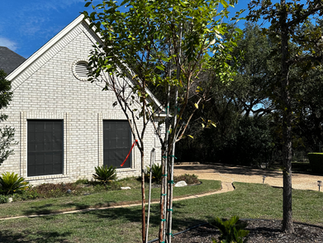The fall is here- it’s time for sweaters, warm coffee, time with family, and… planting trees! Fall weather is the perfect environment to plant a tree. Did you lose a tree to the freeze earlier this year? Or, are you looking to add new trees to your property for one of their many benefits? Our team at Legacy Tree Trimming put together a quick start guide to help you get those trees planted this fall.
Now, you're probably eager to get your hands dirty. Here are the four crucial steps to ensure your tree's success:
Step 1: Pick the Right Tree for the Right Place
There are many factors to consider when planting a tree to ensure the tree will thrive in its surroundings.
Height: How high will the tree grow? Will it grow into anything, such as powerlines, when it's fully grown?
Canopy: How wide does the canopy of the tree grow? Is it a potential hazard to the side or roof of your home?
Growth Rate: How fast does this tree take to mature fully?
Form and Shape: What is the natural shape of the tree? Will it provide shade, or does the tree typically grow upwards narrowly?
Requirements: What requirements does this tree have for sunlight, soil, and moisture?
In Austin, we suggest planting native trees such as live oaks, red oaks, pin oaks, and chinquapin oaks.
Once you have carefully considered these questions and selected a tree, you’re ready to move to the next step.
Step 2: Plant the Tree at the Right Time
In Austin, Texas, and its surrounding cities, the best time to plant a tree is during the fall (October through March). The cooler temperatures and increased rainfall create the perfect conditions for a tree to establish its roots, which sets the tree up for success for a long and healthy life.
A concern that often comes to mind when planting a young tree in the fall is its ability to survive the winter. But, don’t fret! Similar to hibernation, trees go dormant during the winter. During this time when the trees are essentially “sleeping”, their growth, energy consumption, and metabolism slow down. This allows them to stay healthy until they’re ready to come out of dormancy around springtime when the temperatures rise.
You may be wondering, “Why isn’t summer a great time to plant a tree?”. While sunlight is important for a tree's growth, the summers in Texas are harsh for a newly planted tree. The combination of the high temperatures and lack of rain creates a dry environment in the soil, setting the tree's root structure up for failure. Without a strong root structure, a tree has an increased rate of fatality.
Step 3: Time to Dig!
Now that you’ve chosen the best tree for your property and are planting at the right time of year, you’re ready to dig and plant the tree. To get started, you’ll need to gather tools like a shovel and gloves.
It’s important to dig the appropriate size hole for the tree you’re planting. A hole too small can lead to problems like griddled roots, and a hole too big can lead to rotting around the trunk. Generally, the hole should be bowl-shaped and about two to three times as wide as it is deep. The appropriate depth can be determined by the root ball size- you want the depth to equal the height of the route ball.
Here’s a pro tip: do not use the size of the container the tree came in to determine the size of the hole you dig. Often, the container is too small for the tree and the roots begin to grow close to the truck in a circular shape. This does not become a problem if the hole you plant the tree in is wide enough for the roots to continue to expand outward. However, if planted in a hole too narrow, the roots will demand nutrients and water and divert them away from the truck. This will affect the lifespan and health of the tree.
Step 4: Plant and Water the Tree
Now that the tree and its root ball are in place, fill the hole back up with native soil. Rather than using other organic materials to fill the hole, using the native soil will encourage the tree roots to grow and expand.
While backfilling the hole, use your hands to pack in the soil gently. When you’re about halfway, spraying a bit of water onto the soil will help with ensuring there are no air pockets. It’s important to eliminate air pockets because they can result in dead roots as the tree develops.
Once the hole is completely backfilled, gently spray water on the soil and add mulch. Mulch is key in retaining water and moisture for the tree roots.
Each tree's watering requirements are different, so be sure to consider that when picking a tree for your property. A soaker hose or drip irrigation can make tree watering a breeze for you.
Your Tree-Planting Adventure Begins!
And there you have it! You've mastered the art of planting a tree. Now, go out there and embrace the fall season by planting a tree that will not only enhance your surroundings but also contribute to a healthier, happier planet.
If you ever need advice or assistance on planting your dream tree, remember that Legacy Tree Trimming is just a call away. We proudly belong to the International Society of Arboriculture (ISA), and we are wholeheartedly committed to delivering the finest tree care expertise and information. Click here to contact us today!























Comments